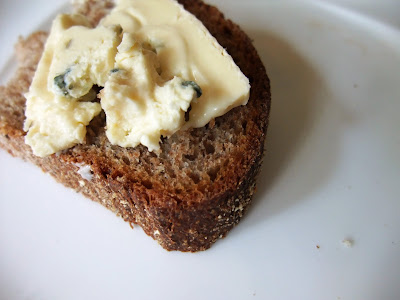Gosh, my oven was running hot today. I was basically all day busy baking, which is a real threat. I spent the last two days hiking, walking around 14 hours in total, so I didn't feel like real physical exercise, the dough-kneading was just perfect.
I was like a bee. Once again, I made a new sesame version of the Whole-Grain Oat crackers (250 g ripe sourdough, made out of 120 g oat flour, 120 ml water and 10 g culture, 210 g whole wheat flour, 9 grams salt, 40 grams sesame seeds, 10 g sesame oil and water as required [probably another 100 ml].) It's pretty easy, actually foolproof. I let it ferment as long as it suits me (this time it was about two hours), then I pressed portions of the dough in either sesame seeds or oats and rolled it thinly with a rolling pin, cut it in pieces and baked it at any oven temperature between 180°C and 230°C until the endges were brown. Et Voila, that's it.

I've made these crackers many times now, using whatever had to be used. Great for leftover sourdough, which has to be used - then I simply use the wheat-based sourdough and add oat flour to the dough instead. I simply follow certain rules, when I "construct" the day's crackers recipe. Like, about 30% of the total flour amount is fermented (sourdough), 2% of the flour weight is salt, the hydration is around 60+ percent . . . It has always worked fine.
Secondly, I baked some whole-wheat Pita bread for todays lunch. Again, this is a classic at my home. We stuffed it with vegetarian burgers (Split lentil burgers, another favourite!), lettuce, tomatoes and Tzaziki.
And last but not least, I continued with my venture into the perfect Yoghurt-Whole-Wheat bread. Unfortunately, the loaves overproofed somewhat during their final rise whe I retarded them in the fridge. (I was out, driving with my dad, getting ready for the driver's license exam.) Luckily they still didn't collapse, just the oven spring wasn't as nice as I experienced the last two times.
Yoghurt-Whole-Wheat-Bread #2


Preferment:
175 ml water
250 g whole-wheat flour (I always use home-ground flour)
1/8 tsp yeast
Final dough
550 g whole-wheat flour
30 g vital wheat gluten
17 g salt
1 teaspoon dry yeast
20 g malt
30 g butter
150 g yoghurt (I used 3% fat yoghurt)
300 ml water
I handled the dough pretty much like described in the last Yogurt Whole-Wheat Recipe. I let the preferment proof for about 12 hours at room temperature, let the remaining flour autolyse for about an hour, kneaded the dough well, let it double (2h), punched it down and let it double again (1.5 h), then, instead of shaping sandwich loaves I made two boules and had to retard them in linned bowls in the fridge (where they overproofed . . . So have an eye on your loaves, better don't retard them and don't go driving for more than two hours.). I baked them for about 40 minutes in 230° C with steam for the first 20 minutes, then lowered the temperature to 215° C for the rest of the bake.

Conclusion: The bread is tasty, but it's probably better baked in a tin at lower temperature. Although I did get a crust, it wasn't an extraordinary flavorful one. This dough benefits from the support it gets from a tin, this way it can become very light and fully proofed. As you can see on the pictures, the bread wasn't flat, but somewhat out of shape (shure, it's overproofed). The crumb texture is again light and pleasant, and the flavor is good! For instance with a piece of blue cheese . . .

What I'm gonna do: I'll keep this recipe in my recipe folder and take it out later again. Now I'm craving less plain breads again, maybe something with dry fruit, nuts, herbs? If I have a bread to often I get bored of it and don't appreciate it anylonger, that's definitely a sign that I should move on.
Very final conclusion: When I bake this bread the next time, then with exactly this formula, but in a bread pan. And I'll bake it at somewhat lower temperature, maybe something around 210°c? Or lower? This bread reminded me of another delicious tin bread, a recipe from Southern Tyrol. I'll have to get this out soon as well. It's a sourdough bread with rye and wheat.
Salome